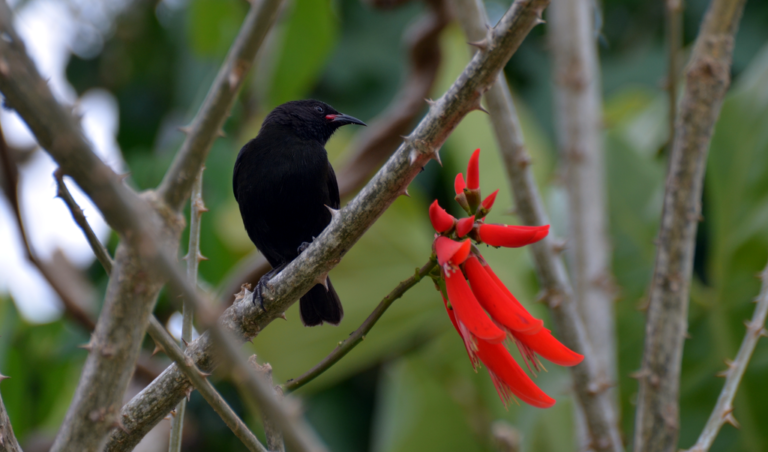Birdfinding.info ⇒ The St. Vincent and Grenadian endemic form of Bananaquit is among the most numerous and ubiquitous birds throughout its small range.
“Dimorphic Bananaquit”
Coereba flaveola aterrima
Family: Thraupidae
Endemic to St. Vincent, the Grenadines, and Grenada, where it occurs in all habitats. Dark morphs typically predominate in wet habitats and pale morphs in dry habitats.
Identification
Two distinctive morphs: one pale and one dark. The dark morph has entirely black or blackish plumage.
The pale morph is readily recognized as a Bananaquit by its curved, sharp-tipped bill, broad white eyebrows, dark brown mask and upperparts, and yellow breast.
Other distinctive features include a yellow rump, yellow shoulders, and a large white spot at the base of the primaries.
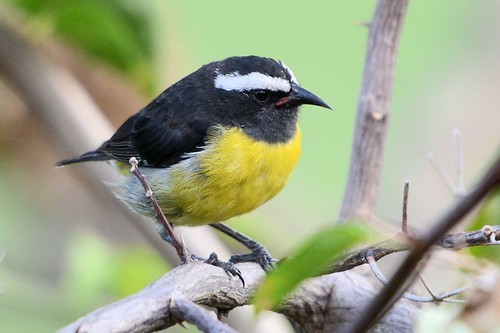
“Dimorphic Bananaquit”, C. f. aterrima, pale morph. (St. George, Grenada; July 23, 2013.) © David Rayner
The pale morph of “Dimorphic Bananaquit” most closely resembles the Bananaquit forms that inhabit the Greater Antilles, Puerto Rico, and the Virgin Islands. These forms all have a white spot on the wings, whereas the “Lesser Antillean” populations of the Leeward Islands south to St. Lucia, Barbados, and the ABC Islands have all-dark wings.
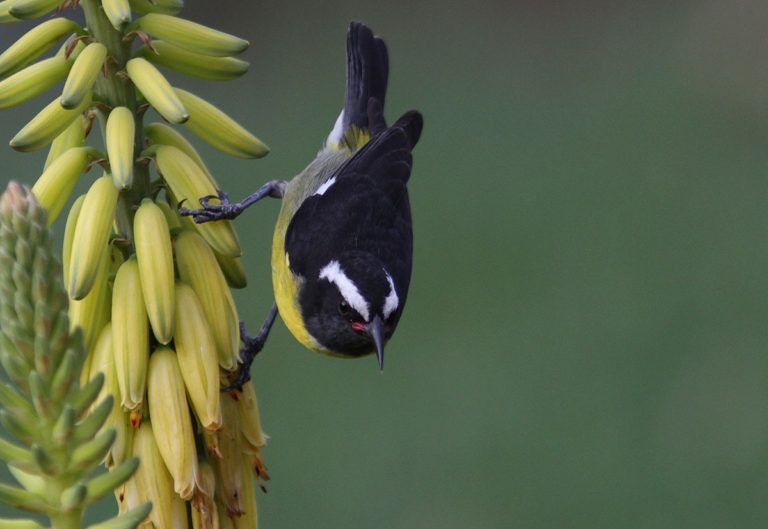
“Dimorphic Bananaquit”, C. f. aterrima, pale morph. (St. George, Grenada; February 28, 2011.) © Mikko Pyhälä

“Dimorphic Bananaquit”, C. f. aterrima, pale morph, showing yellow rump. (Baradol, Tobago Cays, St. Vincent & the Grenadines; February 19, 2011.) © Markus Craig
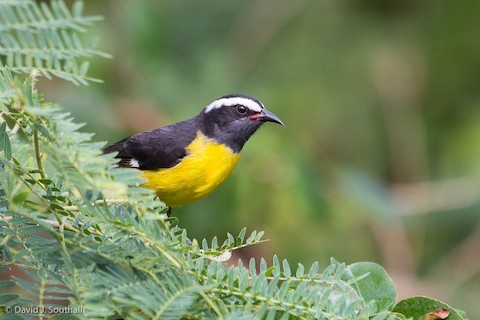
“Dimorphic Bananaquit”, C. f. aterrima, pale morph. (Mustique, St. Vincent & the Grenadines; February 9, 2019.) © David J. Southall
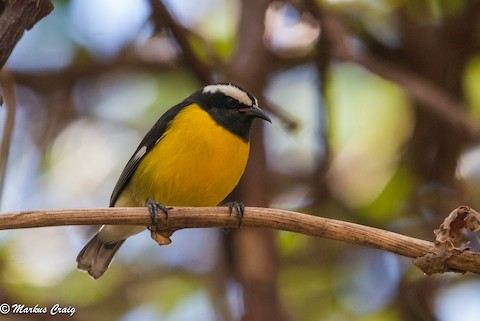
“Dimorphic Bananaquit”, C. f. aterrima, pale morph. (Petite Martinique, Southern Grenadines, Grenada; February 18, 2011.) © Markus Craig

“Dimorphic Bananaquit”, C. f. atrata, pale morph. (Arnos Vale, St. Vincent; January 19, 2019.) © Sue Milks

“Dimorphic Bananaquit”, C. f. aterrima, pale morph. (Prickly Bay, Grenada; April 17, 2009.) © Pat Tucker
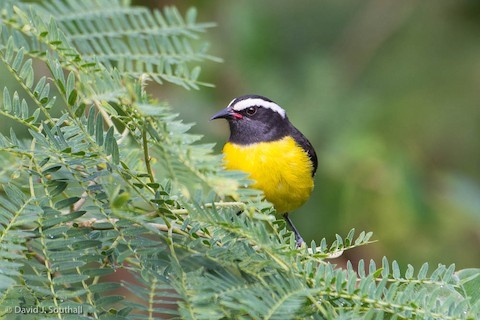
“Dimorphic Bananaquit”, C. f. aterrima, pale morph. (Mustique, St. Vincent & the Grenadines; February 9, 2019.) © David J. Southall

“Dimorphic Bananaquit”, C. f. aterrima, pale morph. (Bequia, St. Vincent & the Grenadines; February 4, 2020.) © Yvonne Burch-Hartley
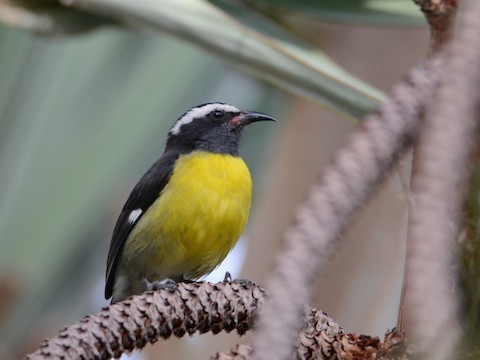
“Dimorphic Bananaquit”, C. f. aterrima, pale morph. (St. George, Grenada; March 14, 2015.) © Alan Van Norman

“Dimorphic Bananaquit”, C. f. aterrima, pale morph. (Tobago Cays Marine Park, St. Vincent & the Grenadines; April 9, 2012.) © Christophe Gouraud
The dark morph of “Dimorphic Bananaquit” closely resembles the “Blackish Bananaquit” of Venezuela’s offshore islands.

“Dimorphic Bananaquit”, C. f. aterrima, dark morph, showing its pink gape. (St. George, Grenada; March 14, 2015.) © Alan Van Norman
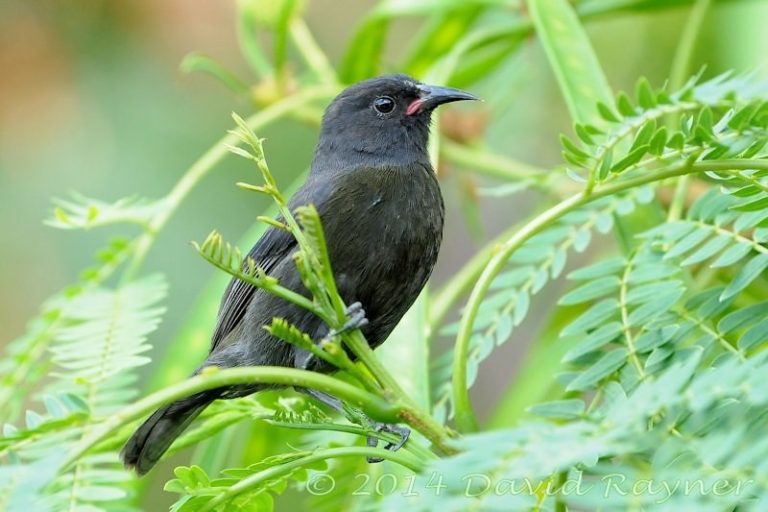
“Dimorphic Bananaquit”, C. f. aterrima, dark morph. (St. George, Grenada; February 7, 2014.) © David Rayner

“Dimorphic Bananaquit”, C. f. aterrima, dark morph. (Morne Jaloux, Grenada; February 21, 2020.) © Dennis S. Main

“Dimorphic Bananaquit”, C. f. atrata, dark morph. (Kingstown Botanical Gardens, St. Vincent; February 23, 2014.) © Stephen Gast

“Dimorphic Bananaquit”, C. f. atrata, dark morph. (Kingstown Botanical Gardens, St. Vincent; November 14, 2009.) © John C. Mittermeier
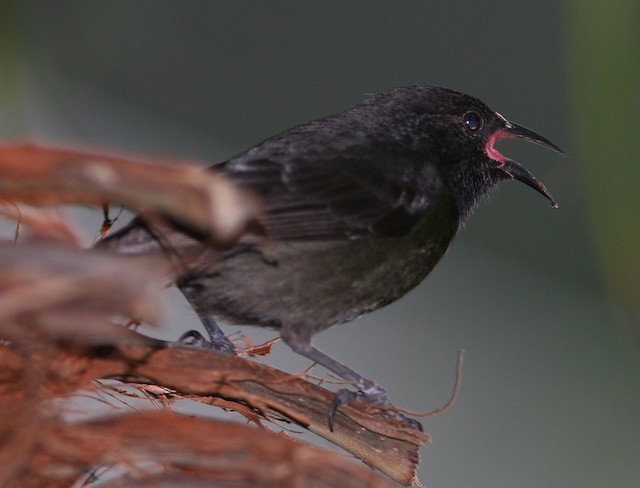
“Dimorphic Bananaquit”, C. f. aterrima, dark morph, showing its pink gape. (St. George, Grenada; February 16, 2009.) © Mikko Pyhälä
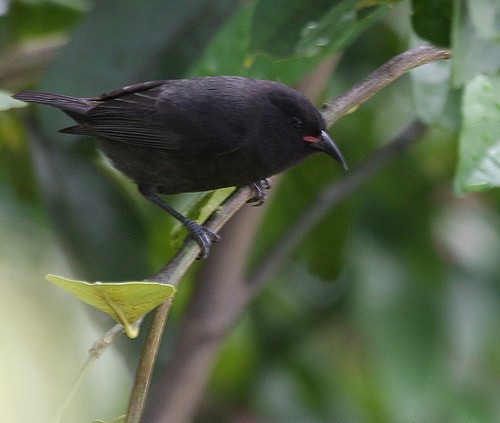
“Dimorphic Bananaquit”, C. f. aterrima, dark morph. (L’Anse aux Epines, Grenada; January 5, 2008.) © Luca Patriccioli
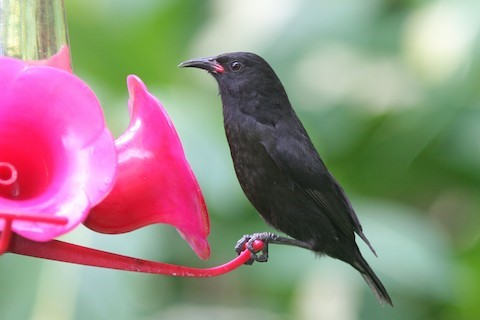
“Dimorphic Bananaquit”, C. f. aterrima, dark morph. (St. David, Grenada; December 15, 2017.) © Larry Therrien

“Dimorphic Bananaquit”, C. f. aterrima, dark morph with grayish underparts. (St. David, Grenada; December 15, 2017.) © Larry Therrien

“Dimorphic Bananaquit”, C. f. atrata, dark morph. (Kingstown Botanical Gardens, St. Vincent; February 23, 2014.) © Stephen Gast
Immatures of the pale morph are similar to adults but have paler, grayer upperparts and mostly dirty-yellow underparts and eyebrows.

“Dimorphic Bananaquit”, C. f. aterrima, light morph, immature. (St. George, Grenada; August 20, 2014.) © Dave Szmyr
Immatures of the dark morph are like adults, but lack the pink gape on the bill.

“Dimorphic Bananaquit”, C. f. aterrima, dark morph, immature—note all-black bill, lacking pink gape. (Morne Jaloux, Grenada; February 21, 2020.) © Dennis S. Main
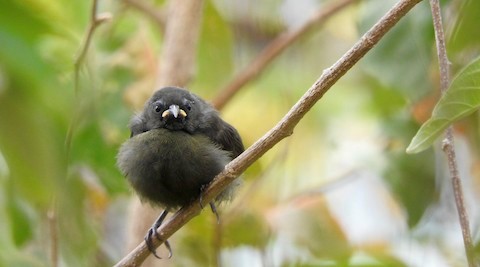
“Dimorphic Bananaquit”, C. f. aterrima, dark morph, juvenile. (Bequia, St. Vincent & the Grenadines; December 31, 2018.) © Noam Markus

“Dimorphic Bananaquit”, C. f. aterrima, dark morph, immature—note all-black bill, lacking pink gape. (Grand Etang Lake, Grenada; January 17, 2018.) © Knut Hansen

“Dimorphic Bananaquit”, C. f. aterrima, light morph, subadult molting into adult plumage. (St. George, Grenada; February 2, 2020.) © Jorge Montalvo
Cf. “Blackish Bananaquit”. The dark morph of the “Dimorphic Bananaquit” of St. Vincent, Grenada, and the Grenadines looks very much like the “Blackish Bananaquit” of Venezuela’s offshore islands. Both are essentially all-dark with a pink gape, and their voices have approximately the same quality. The “Blackish” population of Los Roques is paler than the dark morph of “Dimorphic”, especially on the belly and flanks—but the other populations are not well documented.
Notes
Polytypic form consisting of two recognized subspecies, collectively comprising one of approximately ten potentially distinct forms of Bananaquit. Presumably closely related to the geographically proximal “Blackish Bananaquit” (laurae, melanornis, lowii, and possibly also frailensis), which is extremely similar to the dark morph of “Dimorphic”.
Frontiers of Taxonomy: Bunches of Bananaquits. The forty-or-so subspecies of Bananaquit vary significantly in plumage and voice, and it seems clear that what has traditionally been recognized as a single species consists of several distinguishable forms, which likely represent at least two species, and perhaps as many as ten, but it is a complex puzzle.
Mitochondrial DNA analysis (Bellemain et al. 2008) indicates that the oldest splits are among three lineages: “Bahama” (bahamensis, plus the “Cozumel” subspecies, caboti); “Greater Antillean” (Jamaican flaveola, Hispaniolan bananivora, “Cayman” sharpei, and possibly also the similar “Providencia” form, which includes tricolor and oblita); and the rest (which can be subdivided into “Lesser Antillean” and “Continental” groups).
The same analysis indicates that oldest division among the “Lesser Antillean” lineages is “Puerto Rican” (portoricensis—and possibly also sanctithomae and newtoni of the Virgin Islands), which has the appearance of “Greater Antillean” with a “Lesser Antillean” voice. The analysis also found a significant division between the “Dimorphic” form (aterrima of Grenada and atrata of St. Vincent) and the remaining “Lesser Antillean” subspecies (bartholemica plus martinicana, barbadensis, uropygialis, and bonairensis). Finally, not sampled in the analysis, but apparently related to “Dimorphic”, is the Venezuelan “Blackish” form (laurae plus melanornis, lowii, and possibly also frailensis).
References
Bellemain, E., E. Bermingham, and R.E. Ricklefs. 2008. The dynamic evolutionary history of the bananaquit (Coereba flaveola) in the Caribbean revealed by a multigene analysis. Evolutionary Biology 8:240.
Bellemain, E., O.E. Gaggiotti, A. Fahey, E. Bermingham, and R.E. Ricklefs. 2012. Demographic history and genetic diversity in West Indian Coereba flaveola populations. Genetica 140:137-148.
BirdLife International. 2016. Coereba flaveola. The IUCN Red List of Threatened Species 2016: e.T22722080A94747415. https://dx.doi.org/10.2305/IUCN.UK.2016-3.RLTS.T22722080A94747415.en. (Accessed May 22, 2021.)
eBird. 2021. eBird: An online database of bird distribution and abundance. Cornell Lab of Ornithology, Ithaca, N.Y. http://www.ebird.org. (Accessed May 22, 2021.)
Kirwan, G.M., A. Levesque, M. Oberle, and C.J. Sharpe. 2019. Birds of the West Indies. Lynx Edicions, Barcelona.
Raffaele, H., J. Wiley, O. Garrido, A. Keith, and J. Raffaele. 1998. A Guide to the Birds of the West Indies. Princeton University Press, Princeton, N.J.
Ridgely, R.S., and G. Tudor. 1989. The Birds of South America, Volume I: The Oscine Passerines. University of Texas Press.
Seutin, G., N.K. Klein, R.E. Ricklefs, and E. Bermingham. 1994. Historical Biogeography of the Bananaquit (Coereba flaveola) in the Caribbean Region: A Mitochondrial DNA Assessment. Evolution 48:1041-1061.
Xeno-Canto. 2021. Bananaquit – Coereba flaveola. https://www.xeno-canto.org/species/Coereba-flaveola. (Accessed May 22, 2021.)
